How To Choose The Perfect Tank For a Leopard Gecko
A vivarium for your leopard gecko is equivalent to the house, apartment, or condo you are staying in – where you might be lounging at right now while reading this article. Would you like to live in an 11-square-foot house like this one in Berlin? Probably not for everyone.
The same consideration you have when choosing a home applies to your little friend. A great enclosure will be your little reptilian baby’s house for many years to come, so it’s essential to make sure they feel safe, comfortable, and happy living in it!
As a general rule, the following aspects need to be taken into consideration when choosing a tank for your leopard gecko:
- Internal Capacity
- Dimensions
- Opening
- Ventilation
- Material
- Type of Build
Homing in on the perfect vivarium for your precious gecko? Make sure it meets these requirements first!
6 Things to Consider Before Housing a Leopard Gecko
In your opinion, what makes a house a home? For me, it’s a combination of many things which includes a fully equipped kitchen, big windows, a well-lit bedroom, and a spacious bathroom. But what makes a vivarium a home for our adorable geckos? Well, I’ll discuss them with you in as much detail as I possibly can.
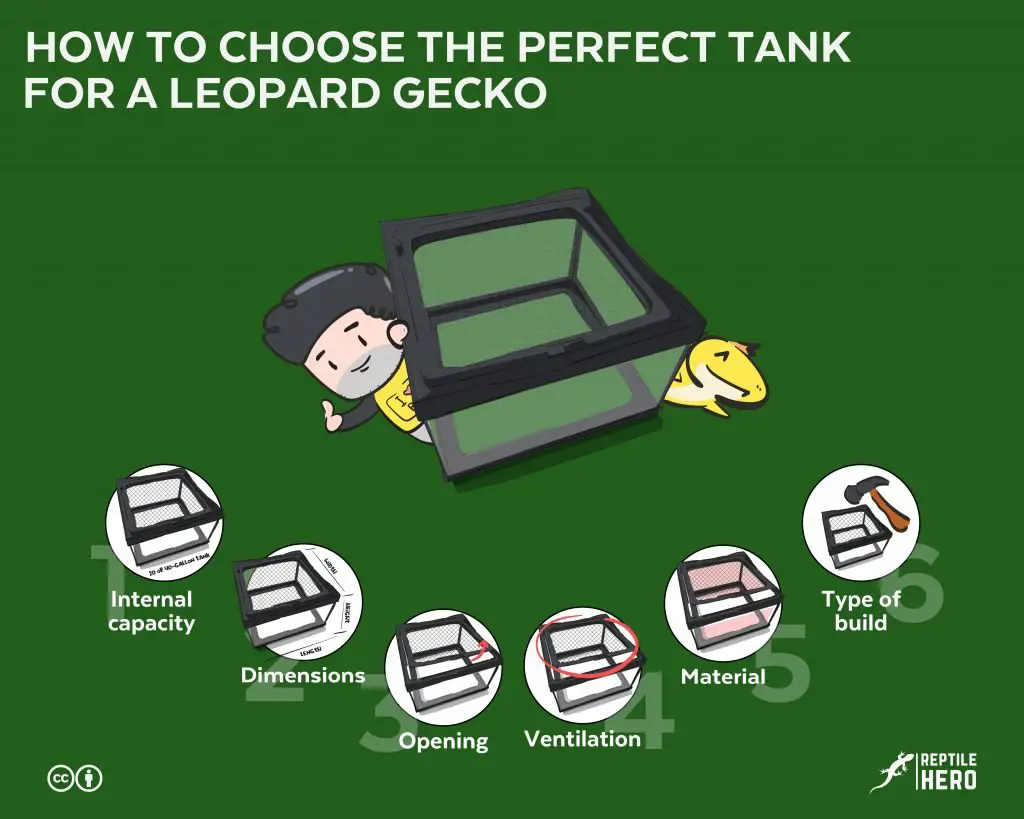
#1 – Internal Capacity
The average fully grown adult leopard gecko will thrive in a 40-gallon breeder or 40-gallon long tank. However, a 20-gallon tank may also suffice for an adult leopard gecko.
When selecting the perfect vivarium for your soft-scaled precious little companion, the internal capacity is the first thing you should always take into consideration. Others mistakenly believe that big spaces scare and stress leopard geckos but that is more of a misconception than it is a fact.
A gecko’s vivarium must have more than enough room to fit at least one of each provision:
- Humid hide
- Dry cool hide
- Dry warm hide
- Supplement bowl
- Water bowl
- Food bowl
- Plants (real and/or fake)
- Rock formation/insert
- Log/branch
Considering the rapid development they undergo, the appropriate tank size for a single leopard gecko is highly dependent on what stage they currently are in life as well as their size – their, snout-vent-length. However, if you have limited free space in your house, apartment, or room, you could gradually switch to bigger tanks instead.
For a hatchling leopard gecko, a 10-gallon tank would provide more than enough room for it to grow. However, most vivarium decors, furnishings, and accessories are made for adults. So you would most likely need to create handmade provisions. Juvenile and adult leopard geckos should be individually housed in an enclosure that is a minimum of a 20-gallon long enclosure.
#2 – Dimension
A single leopard gecko should be housed in a vivarium that is at least 12 inches (30 cm) tall and has 3 square feet (0.28 square meters) of floor space. Most 20-gallon reptile vivariums that are 24 inches (60 cm) in length, 18 inches (45 cm) in width, and 12 inches (30 cm) in height meet this minimum requirement.
Despite the fact that leopard geckos lack the sticky toe pads that enable arboreal lizards such as crested geckos to scale walls, steep terrains, and walk upside-down along ceilings, they are still fantastic rock climbers. In fact, they have really small but sharp claws which enable them to dig deep into the ground or climb deep into caves and crevices in high areas.
Contrary to popular belief, leopard geckos should actually be housed in generously sized tanks that both provide enough head and floor space [1, 2]. Whether housed by itself or in a small group, a leopard gecko must have enough room to burrow into the substrate, climb onto rock formations and branches, as well as explore.
To be quite frank though, all of us here at Reptile Hero recommend much larger tanks at least 36 inches (90 cm) in length and 18 inches (45) in both width and height. By doing so, we can go for naturalistic or bioactive set-ups without taking away significant space for our geckos to roam around in. We also get the option to place lights and heaters inside.
Needless to say, a vivarium that closely mimics their natural habitats will raise the likelihood of your leopard gecko being active and prevent geckos from becoming overweight or obese due to overfeeding and lack of exercise. Many other keepers can attest to this.
A big tank with a deep base, ample surface area, high ceiling, plenty of hides, and sufficient foliage will encourage these terrestrial reptiles to move about and engage in regular exercise. Some people might think all of that is unnecessary since leopard geckos will survive in a small tank. However, surviving is entirely different from thriving. For your gecko to thrive, it should exhibit common behaviors displayed by its wild counterparts.
Moreover, a rectangular enclosure is preferred over cubed ones since the added length makes it easier for keepers to maintain an optimum thermal gradient within the tank. This, in turn, allows for our cold-blooded little critters to thermoregulate without much issues or difficulty.
#3 – Opening
Enclosures designed with a combination of front and top-opening access points are preferred for easier reptile keeping in terms of convenience for decorating, cleaning, feeding, and handling.
When you start researching for the perfect tank for leopard geckos, you’re sure to come across different tanks with three main types of doors or openings: 1) top, 2) front, and 3) combo. Each gecko owner, of course, has their own preferences. However, I want to discuss the pros and cons of each one from a more objective point of view.
Top Opening
Most starter kits for terrestrial lizards like leopard gecko usually include a glass tank that resembles the common aquarium. The only difference is that the enclosures made especially for reptiles are equipped with a mesh lid made with plastic, wire, or both. This addition ensures that your leopard gecko doesn’t escape and won’t get suffocated. It’s also easier to design and decorate when you have an aerial perspective of your vivarium layout.
Top-opening vivariums are not recommended because:
- Having this as the only point of access can be stressful for leopard geckos as their natural predators in the wild would normally swoop down from above.
- If you have one that’s only 10 or 20 gallons, you probably have the light, heaters, and other fixtures set on top of the lid. Having to move those before and after each time you check in on your gecko can be an incredibly troublesome vivarium with top openings products.
This is also the usual point of access for the plastic rack and tub systems old-school breeders use. I’m not a fan of this method for multiple reasons, one of them being the fact that you’re basically subjecting your leopard gecko to mini earthquakes each time you close and open their tank. (I will discuss this in greater detail later on in the article.)
Front Opening
Another type of entry point for reptile enclosures is front-opening ones. The front-opening type can further be divided into two styles: 1) hinged and 2) sliding.
Functionally, they are pretty much identical, both styles work equally great. Pet parents or leopard geckos who have switched from top to front-opening vivariums, I and my team included, have observed significant differences in our little ones’ behavior when we go in to pick them up. Since they can clearly see us front the same level when we approach them for handling, they are much less jumpy and scared. However, they do have minor differences.
Leopard gecko vivarium enclosures with hinged front doors usually make use of clear plastic or glass materials then frame the panels in wood, metal, plastic, or a mixture of all three. As such, these usually come at a higher price compared to top opening tanks of the same capacity and dimension. They may also come with a simple or complicated locking mechanism which may or may not be secured with a key.
Leopard gecko vivarium with swinging hinged doors should be avoided.
This is because the door continuously moves about unless you personally hold it in place. I’ve also heard of horror stories where keepers have inadvertently applied too much force while trying to close such doors for it to slam into place and get cracks and chips. If you do experience this, immediately have it replaced so broken pieces don’t rain down your gecko’s home.
Vivariums with sliding front doors use either completely transparent plastic or glass as their main materials. If you have an incredibly fast and sneaky gecko that acts like a protagonist from a heist movie, this would be perfect for you because you can adjust how open you’d need the door to be. When offering live feeder insects that hop or crawl about, you can open it just a crack so it doesn’t escape either.

The downside is, substrate and feeders may get caught in between the sliding doors and their tracks. But you can easily sweep that away so I don’t really mind it when it does happen to me.
Tanks with sliding doors may or may not be built with a security mechanism, it varies among different manufacturers. It may also be removable or permanently fixed into the unit. Personally, I especially love Zen Habitat’s sliding door enclosures since they are removable for easier cleaning and they have metal door wraps and a simple keyless locking feature.
Combo Opening
Tanks with a combination of top and front access points have steadily grown a following within the reptile-keeping community. The only catch is: it usually comes with a hefty price tag. Nowadays, most well-known brands that create readily available enclosures offer models with this type of opening.
With vivariums that have front doors as well as removable top screens, you get the best of both worlds. Like the aquarium-type tanks, you have an aerial view of your leopard gecko’s whole housing. Another perk is that you can drop sprightly live feeder insects like crickets from the top so they don’t easily escape during feeding.
Because there is also front door access, you won’t have to worry about scaring, or worse, dropping your cute little leopard gecko whenever you have to take it out of its home. This factor is incredibly important especially when you are still trying to get a new gecko used to you and its new home.
Plus, if you need to place a custom tank piece – say, a big fake rock mountain background complete with hides and caves – being able to get into every nook and cranny of the vivarium from the front and top will make measurements more accurate and designing much easier. The same goes for cleaning and maintenance as well, you won’t miss a spot.
#4 – Ventilation
A vivarium for the average leopard gecko should have large air vents by the walls or a mesh top to promote ample airflow and aid in maintaining the proper level of humidity.
Leopard geckos originate from countries with semi-arid deserts, as well as dry, rocky grasslands [3]. In such areas, their wild relatives are rarely out in the open, exposed to predators. To ensure their safety, they will seek shelter deep down into the soil (containing clay and sand) or high up in gaps of rock mounds. Rarely will they be completely closed off from the rest of the world.
Taking such facts into consideration, these magnificent animals will not do well in a stuffy enclosure with constantly high humidity levels. Keep humidity levels within the 30% to 40% range for leopard geckos [4]. Anything less or more than that will cause health problems such as retaining shed skin and bacterial infections.
Remember, despite making sure that everything you place inside your gecko’s vivarium is clean and sterile, if you do not practice proper husbandry, mold and bacterial growth are inevitable. To prevent such problems, make sure to have a hygrometer (here on Amazon) to monitor the humidity level in the tank.
Additional ventilation holes should be drilled on the walls or roof of a leopard gecko’s enclosure if humidity spikes higher than 40%. However, don’t leave any hole as is. Cover them with slit-type vents of fine mesh Conversely, when humidity levels dip way below 30%, cover up some of the vents to raise it.
Be ready to make adjustments whenever necessary.
#5 – Material
Wood is the best material to use for building a leopard gecko vivarium. In combination with a steel mesh top and a clear glass or plastic front door, these materials will facilitate optimal humidity and temperature levels while keeping your gecko safe and secure.
Keep in mind that if you are staying in a place that experiences extremely hot summers, freezing winters, or really bad humidity, you will need to consider what materials make up the vivarium you are planning to procure.
Below are the four major categories of materials used for constructing various types of housing for reptiles and amphibians.
Mesh
Though a leopard gecko will greatly benefit from living in a vivarium built with a mesh top because it supplies sufficient ventilation, your soft-bellied friend should never be housed in a vivarium that is entirely made of such material as the risks would easily outweigh the benefits.
A 100% (or even just 90%) metal mesh enclosure is not recommended for leopard geckos. First of all, that would basically be an electrocution chamber and a major fire hazard [5]. Water, metal, heat, and electricity won’t mesh together well.
Furthermore, such a set-up won’t allow for proper humidity and temperature control, and monitoring. It’s too open. Even if you only use metal mesh panels for the four walls of your gecko’s house, no matter how fine the holes are, there is a high risk of injury.
If you do get a vivarium with a mesh cover, make sure that the steel has been galvanized and sterilized before construction. Why? Well, it can be potentially non galvanized metal materials that are potentially toxic to geckos and other reptiles [6]. I mean, just think of rusting from regular misting and humidity.
However, do keep in mind the metal will work great not just for ventilation screens but for framing as well. They will increase the structural integrity of your enclosure. Lastly, metal can be bent, shaped, and cut however you would like it to be if you know the right tools and methods to use.
Plastic
Now let’s talk about one of the more debated materials used in building readily available and easy-to-assemble vivariums in the hobby: plastic. They are durable in that they don’t decompose or rot easily. A not-so-fun fact: your regular plastic shopping bag will take about 10,000 years to fully break down [5]. However, this doesn’t necessarily mean that plastic products are indestructible.
In fact, multiple other reptile owners have had problems with cheaply made, mass-produced enclosures because the plastic used in their construction melt and warp too easily. Such a situation would certainly be frustrating for any keeper or breeder because the absence of a good light and heat source could be detrimental to a gecko’s health. There have even been reports of plastic releasing fumes once subjected to high temperatures.
On the bright side though, some plastics have been created to withstand electricity, water, and chemical corrosion. They also hold up well to heat and humidity. Plus, since they are lightweight, you can easily move them around when necessary. Such plastics are the ones you should look for in a vivarium.
Safe plastic materials for leopard gecko vivariums include:
- Polyvinyl chloride (PVC)
- Acrylonitrile butadiene styrene (ABS)
- Polypropylene (PP)
- Acrylic
However, I’m against the practice of keeping leopard geckos and other exotic animals in the plastic rack and tub systems. These are not suitable for long-term housing as they do not allow for proper lighting, heating, ventilation, and enrichment. Even if you buy those large storage bins, remember that they were never marketed as reptile enclosures for a reason.
Small plastic enclosures, like this one on Amazon, are only great options for temporary housing in the event that you would need to visit your local veterinarian, travel a far distance, quarantine a sick or new gecko, or deep clean your large vivarium.
Glass
The most commonly available types of reptile enclosures are usually made with glass. But what exactly is sand? How is it made?
Glass is the product of heating sand, silicon dioxide in particular, at a very high temperature of more or less 3,092°F (1,700°C) where it becomes a liquid substance. Once it cools down, it transforms into the clear solid we are most familiar with [5].
What makes glass popular for making enclosures include its transparency, hardiness, and resistance to heat and water. It’s perfect for holding in a steady amount of humidity. Placing decors and accessories inside is also a piece of cake with suction cups and some silicone adhesive. It’s perfect for bioactive set-ups since it can hold a lot of weight too. So glass enclosures usually sell at an expensive price point.
However, glass should never be in direct contact with a heat source for a long period of time as it will crack. Other drawbacks include its inability to retain heat. To combat this, many creative keepers have decided to create insulating naturalistic backgrounds and inserts with spray foam, animal-safe sealant, and many other things. Here’s a great example:
As you can see, a fully decorated leopard gecko vivarium also serves as an attractive display in your home. You just have to be mindful of where you place it so the less appealing backside doesn’t show.
There have also been discussions on how the reflective nature of glass can be distressing for leopard geckos. Some have claimed that these little creatures are incapable of identifying their reflections and would therefore see themselves as possible threats. Hence, glass tanks would prove to be quite stressful housing environments.
Other reptile species have shown that this is indeed the case, chameleons would change color upon seeing their reflections [7]. But in a study wherein mirrors were used as enrichment items [8], leopard geckos showed little to no significant changes in behavior upon seeing their reflections – be it social, defensive, or aggressive.
Wood
Enclosures made primarily from wood have become increasingly popular with regular keepers, as well as professional breeders and exotic animal experts. However, since vivariums are harder to find, they usually fetch a high price.
In previous sections of this article, I have lauded the convenience and advantages of having clear vivariums. However, as the years went by and I had more experience with keeping leopard geckos, I realized that glass enclosures work better for my preference that it does for my pet’s well-being. Although a naturalistic clear enclosure does make for a great conversation starter and display, it may actually be stressful for geckos to be so exposed.
Wooden vivariums from Zen Habitats are a great solution for this as the sides and back provide more than enough privacy and security while the transparent front doors and mesh ceiling allow for non-intrusive viewing.
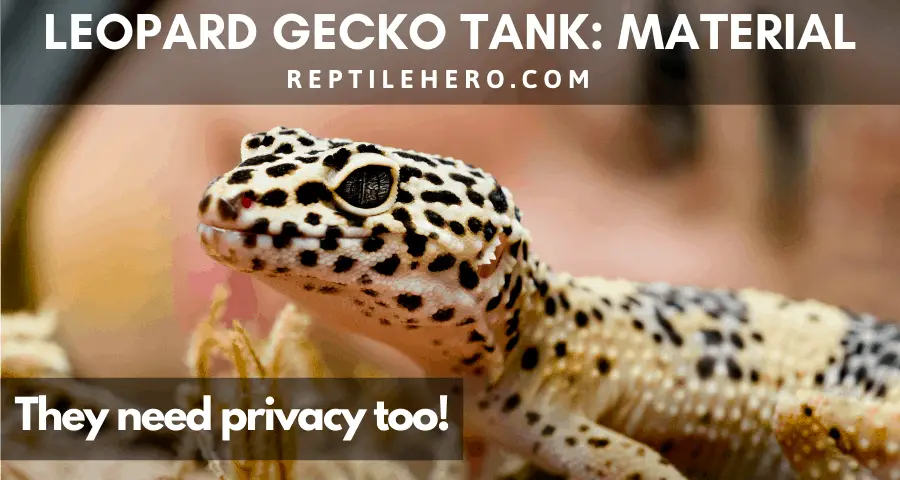
Besides that, wood retains heat up to 10 times better than glass and provides great insulation from the cold [5]. So if you experience exceptionally chilly winters year after year, ditch your glass enclosure for wood one. Just don’t place it in an area that receives plenty of direct sunlight as it may act like an oven and overheat [9].
Safe wood materials for leopard gecko vivariums include:
- Marine plywood
- Melamine
- Oak
- Magnolia
- Birch
- Oriented strand board (OSB)
I’m still on the fence as to whether cedar, pine, and other sap-heavy woods are actually safe for prolonged exposure to reptiles. Some claim that these are 100% toxic to not only reptiles but rodents as well. On the other hand, others contend that any wood is basically non-toxic as long as it has been properly kiln-dried, treated, and sealed.
Lastly, keep in mind that wood is odor and moisture-absorbent. As a result, it may rot if not sealed and treated properly. However, since leopard geckos need a drier environment compared to tropical species like cresties, this shouldn’t pose much of a problem.
#6 – Type of Build
One of the most important things beginner reptiles parents fail to consider when planning to select the perfect home for their reptiles is the type of build. However, each type comes with its own advantages and disadvantages.
Certain types may better suit very specific needs and living situations of certain people, while others may be great for everyone.
Do-It-Yourself
Nowadays, more and more people have gone for the DIY route when it comes to creating the perfect home for the reptiles and amphibians in their care.
Pros of DIY vivariums:
- You can pick and choose the materials you want
- It costs a lot less when you do it yourself
- Options for customization is practically endless
Cons of DIY vivariums:
- Takes a lot of time to complete
- Materials can be hard to procure
- A complete set of tools and equipment are needed (if you do not have them the initial savings can be easily offset by the tools you might need to buy).
- You should have dedicated space for construction
Would I recommend this to everyone? The short answer is: no. Don’t get me wrong, I’m all for doing things from scratch. However, the reality is not everyone has the right tools and skills to pull off a functional and beautiful handmade vivarium.
Ready-Made
Most enclosures designed for leopard geckos that are readily available fall into this category. Ready-made tanks are still a reliable go-to option for most reptile owners.
Pros of ready-made vivariums:
- Easy to find in local shops and online
- Lots of styles and sizes available
- Damaged parts are usually replaceable
Cons of ready-made vivariums:
- Can be pricey once the delivery fee is included
- Could break during delivery
A considerable number of reptile enthusiasts go for ready-made vivariums because they either come fully constructed or in parts that are easy to put up. It’s also easier to choose the right brand since most manufacturers have online shops with reviews you can go through yourself.
Custom-Built
Though a lot of people have started keeping reptiles, not everyone has the time, talent, tools, and space to construct a completely customized enclosure for reptiles. Because of this, getting in touch with experienced reptile enclosure builders is a great choice. You get the pros of DIY and ready-made vivariums by having yours custom-built by experts.
Pros of custom-built vivariums:
- Have it designed as you wish
- Best quality possible
- Eliminate stress and effort needed
- You will get expert advice from professionals
- 100% personalized to suit your needs and wants
- In case something breaks you know how to repair it straight away
Cons of custom-built vivariums:
- It may be expensive due to labor costs
- Could take a long time to complete
Now, this type of build I would recommend for keepers from all walks of life and varying levels of expertise. You may just need to save up more money. Then again, some of the cheap and poorly built ready-made tanks sell for exorbitant prices.
To Splurge Or Not To Splurge?
Like I have already mentioned again and again in the previous sections of this article, going for the more affordable alternatives or solutions doesn’t always end up with the greatest outcome. Sure you might save some money by choosing the least expensive products and materials available in the beginning.
However, as time goes on, you might face problems with your vivariums again and again (e.g., replacing parts, frequent upgrades) that would prove to be more costly and stress-inducing in the long run.
Personally, I think the best way to go about things in life – that includes proper reptile keeping – is to search for the best possible option even if it is pricier than you initially anticipated. If you don’t have enough money, then save up for the best vivarium instead of getting the cheapest product of unknown quality and reputation.
I mean come on, no one is going to refuse a good deal. But there is probably a big and crucial reason why that cheap vivarium or mysterious origin isn’t selling. Good pet parents will only go for the cheapest products if they have been tried, tested, and proven safe for our reptile babies.
What To Do With Your Old and Small Enclosure?
It’s common for most new reptile keepers to begin their journey using the small tanks that usually come with a complete starter kit. This isn’t bad per se since going from the more modest set-up and then gradually scaling up to more advanced and artsy set-ups as time goes on provides a great learning experience.
But what is a keeper to do with those tiny tanks that their little dinosaur-like friends quickly outgrew?
Here are three things you can do to deal with old and small enclosures.
Keep
If you only have one or two of these small tanks, you should keep them. They make for great temporary and quarantine enclosures. You could also up-cycle it into a storage unit or anything of the like.
Give
If you have amassed a number of small tanks which your little dinosaur babies have outgrown, give them away. You can donate it to rescue shelters or clinics. But if you’re strapped for cash, you also have the choice to sell it to other keepers. Go with whichever would be great for you.
Throw
If there are major damages that can no longer be repaired, or if it would cost you more money to do repairs than it would to buy a brand new one of the same size, trash it. Just make sure to throw it away properly.
For example, if you live in New York and you have to dispose of your broken glass vivarium by covering it up in sheets of old newspaper, storing it in a cardboard box, and then labeling it with “broken glass” to avoid injuries [10].
Takeaways
A tank should at least have a 20-gallon capacity to house one adult leopard gecko. Most 20-gallon reptile enclosures are 24 inches (60 cm) in length, 18 inches (45 cm) in width, and 12 inches (30 cm) in height.
Vivariums with only top access points are not recommended. Models with front or combo (top and front) are recommended because they are safer and more convenient for reptile-keeping. Leopard geckos are native to dry regions with low levels of humidity (30-40%). As such, its tank should have air vents, a mesh ceiling, or both.
The best material to use for building a leopard gecko’s vivarium base is kiln-dried, sealed wood. A steel mesh top and a clear glass or plastic front door will facilitate optimal ventilation, humidity, temperature, and visual security.
You can build your own vivarium, buy a mass-produced model, or have your leopard gecko’s tank custom-made by an experienced professional. Each type of build has its own pros and cons so choose the one which fits your situation best.
Sources
[1] https://canobievet.com/wp-content/uploads/2018/02/Leopard-Gecko-Care.pdf
[2] https://www.rvc.ac.uk/Media/Default/small-animal/documents/Leopard-gecko-care-sheet-1.pdf
[3] https://en.wikipedia.org/wiki/Common_leopard_gecko
[5] https://letstalkscience.ca/educational-resources/backgrounders/types-materials
[6] https://www.americanhumane.org/app/uploads/2016/08/op-guide-reptilecare.pdf
[8] https://www.sciencedirect.com/science/article/abs/pii/S0168159116302350

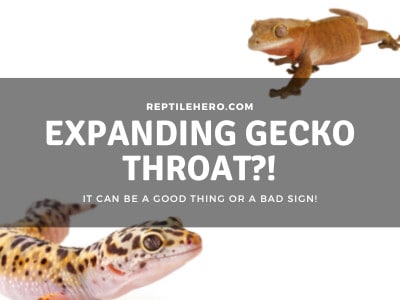
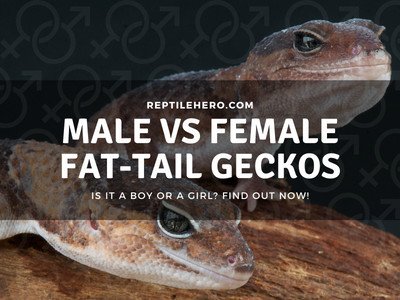
![Leopard Gecko Morphs 101 [Rarity, Price, and Color]](https://www.reptilehero.com/wp-content/uploads/2021/03/word-image-34-768x576.png)
![Why Does Your Gecko Have Red Eyes? [6 Reasons]](https://www.reptilehero.com/wp-content/uploads/2021/03/Why-gecko-red-eyes-reasons-768x614.jpg)
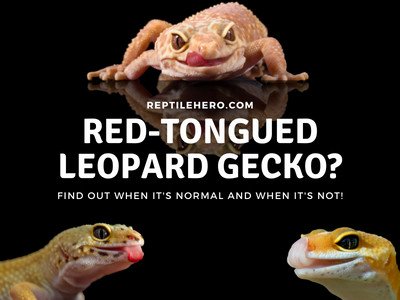
![How Much Electricity Does a Gecko Use? [Full Bill Breakdown]](https://www.reptilehero.com/wp-content/uploads/2021/05/word-image-20-768x576.png)